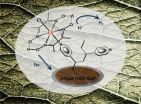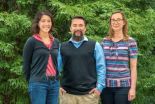(Press-News.org) There's promising news from the front on efforts to produce fuels through artificial photosynthesis. A new study by Berkeley Lab researchers at the Joint Center for Artificial Photosynthesis (JCAP) shows that nearly 90-percent of the electrons generated by a hybrid material designed to store solar energy in hydrogen are being stored in the target hydrogen molecules.
Gary Moore, a chemist and principal investigator with Berkeley Lab's Physical Biosciences Division, led an efficiency analysis study of a unique photocathode material he and his research group have developed for catalyzing the production of hydrogen fuel from sunlight. This material, a hybrid formed from interfacing the semiconductor gallium phosphide with a molecular hydrogen-producing cobaloxime catalyst, has the potential to address one of the major challenges in the use of artificial photosynthesis to make renewable solar fuels.
"Ultimately the renewable energy problem is really a storage problem," Moore says. "Given the intermittent availability of sunlight, we need a way of using the sun all night long. Storing solar energy in the chemical bonds of a fuel also provides the large power densities that are essential to modern transport systems. We've shown that our approach of coupling the absorption of visible light with the production of hydrogen in a single material puts photoexcited electrons where we need them to be, stored in chemical bonds."
Moore is the corresponding author of a paper describing this research in the journal Physical Chemistry Chemical Physics titled "Energetics and efficiency analysis of a cobaloxime-modified semiconductor under simulated air mass 1.5 illumination." Co-authors are Alexandra Krawicz and Diana Cedeno.
Bionic leaves that produce energy-dense fuels from nothing more than sunlight, water and atmosphere-warming carbon dioxide, with no byproducts other than oxygen, represent an ideal sustainable energy alternative to fossil fuels. However, realizing this artificial photosynthesis ideal will require a number of technological breakthroughs including high performance photocathodes that can catalyze fuel production from sunlight alone.
Last year, Moore and his research group at JCAP took an important step towards the photocathode goal with their gallium phosphide/cobaloxime hybrid. Gallium phosphide is an absorber of visible light, which enables it to produce significantly higher photocurrents than semiconductors that only absorb ultraviolet light. The cobaloxime catalyst is also Earth-abundant, meaning it is a relatively inexpensive replacement for the highly expensive precious metal catalysts, such as platinum, currently used in many solar-fuel generator prototypes.
"The novelty of our approach is the use of molecular catalytic components interfaced with visible-light absorbing semiconductors," Moore says. "This creates opportunities to use discrete three-dimensional environments for directly photoactivating the multi-electron and multi-proton chemistry associated with the production of hydrogen and other fuels."
The efficiency analysis performed by Moore and his colleagues also confirmed that the light-absorber component of their photocathode is a major bottleneck to obtaining higher current densities. Their results showed that of the total number of solar photons striking the hybrid-semiconductor surface, measured over the entire wavelength range of the solar spectrum (from 200 to 4,000 nanometers) only 1.5-percent gave rise to a photocurrent.
"This tells us that the use of light absorbers with improved spectral coverage of the sun is a good start to achieving further performance gains, but it is likely we will also have to develop faster and more efficient catalysts as well as new attachment chemistries. Our modular assembly method provides a viable strategy to testing promising combinations of new materials," Moore says.
"Efficiency is not the only consideration that should go into evaluating materials for applications in solar-fuel generator technologies. Along with the durability and feasible scalability of components, the selectivity of photoactivating a targeted reaction is also critical. This is where molecular approaches offer significant opportunities, especially in catalyzing complex chemical transformations such as the reduction of carbon dioxide."
INFORMATION:
JCAP, which has a northern branch in Berkeley and a southern branch on the campus of the California Institute of Technology (Caltech), was established in 2010 by the U.S. Department of Energy (DOE) as an Energy Innovation Hub. Operated as a partnership between Caltech and Berkeley Lab, JCAP is the largest research program in the United States dedicated to developing an artificial solar-fuel technology. It is funded through the DOE Office of Science.
Promising news for solar fuels from Berkeley Lab researchers at JCAP
2014-03-07
ELSE PRESS RELEASES FROM THIS DATE:
Anti-psychotic medications offer new hope in the battle against glioblastoma
2014-03-07
Researchers at the University of California, San Diego School of Medicine have discovered that FDA-approved anti-psychotic drugs possess tumor-killing activity against the most aggressive form of primary brain cancer, glioblastoma. The finding was published in this week's online edition of Oncotarget.
The team of scientists, led by principal investigator, Clark C. Chen, MD, PhD, vice-chairman, UC San Diego, School of Medicine, division of neurosurgery, used a technology platform called shRNA to test how each gene in the human genome contributed to glioblastoma growth. ...
Agricultural fires across the Indochina landscape
2014-03-07
Agricultural fires are still burning in Indochina ten days after the last NASA web posting about the fires. This natural-color image, taken on March 07, 2014, by the Moderate Resolution Imaging Spectroradiometer, MODIS, aboard the Aqua satellite, shows a more comprehensive area of burning agricultural fires that stretch from Burma through to Laos and south throughout Thailand. Actively burning areas, detected by MODIS's thermal bands, are outlined in red.Fire is used in cropland areas for pest and weed control and to prepare fields for planting. Crop residue burning helps ...
NYU researchers find majority of Latinas are unaware of their risk of diabetes
2014-03-07
Approximately 5.5 million Latinas suffer from elevated fasting plasma glucose (FPG) and nearly 4 million of those women were never told by a healthcare provider they were at risk for diabetes, pre-diabetes, or were borderline for diabetes.
The study, "Latinas with Elevated Fasting Plasma Glucose: An Analysis Using NHANES 2009-2010 Data," led by Dr. Shiela M. Strauss, Associate Professor, New York University College of Nursing (NYUCN), points to the urgent need for alternate sites of opportunity for diabetes screenings. There is also a need for effective and culturally ...
Smartphones become 'eye-phones' with low-cost devices developed by Stanford
2014-03-07
STANFORD, Calif. — Researchers at the Stanford University School of Medicine have developed two inexpensive adapters that enable a smartphone to capture high-quality images of the front and back of the eye. The adapters make it easy for anyone with minimal training to take a picture of the eye and share it securely with other health practitioners or store it in the patient's electronic record.
"Think Instagram for the eye," said one of the developers, assistant professor of ophthalmology Robert Chang, MD.
The researchers see this technology as an opportunity to increase ...
For older drivers, study finds, 1 drink may be 1 too many
2014-03-07
GAINESVILLE, Fla. — You may have only had one glass of wine with dinner, but if you're 55 or older, that single serving may hit you hard enough to make you a dangerous driver.
So, baby boomers, what you suspected is true: you can't party like you used to.
Sara Jo Nixon, Ph.D., a professor in the departments of psychiatry and psychology at the University of Florida and doctoral candidate Alfredo Sklar tested how drinking legally non-intoxicating levels of alcohol affect the driving skills of two age groups: 36 people ages 25 to 35 and 36 people ages 55 to 70. They found ...
Software analyzes apps for malicious behavior
2014-03-07
This news release is available in German.
Last year at the end of July the Russian software company "Doctor Web" detected several malicious apps in the app store "Google Play". Downloaded on a smartphone, the malware installed — without the permission of the user — additional programs which sent expensive text messages to premium services. Although Doctor Web, according to its own statement, informed Google immediately, the malicious apps were still available for download for several days. Doctor Web estimates that in this way up to 25,000 smartphones were used ...
Cells appearing normal may actually be harbingers of lung cancer
2014-03-07
HOUSTON -- Seemingly healthy cells may in fact hide clues that lung cancer will later develop, according to a study led by researchers at The University of Texas MD Anderson Cancer Center The research is published online in the Journal of the National Cancer Institute.
Examination of gene expression in patients with non-small cell lung cancer (NSCLC) showed the area adjacent to tumors is rich with cancer markers. In addition, researchers discovered the previously unknown role of a cancer-promoting gene in the airways of smokers with lung cancer.
"We believe this study ...
Pre-term birth and asthma
2014-03-07
Researchers at Brigham and Women's Hospital (BWH) in Boston, Massachusetts, in collaboration with investigators at the Maastricht University Medical Centre and Maastricht University School of Public Health in the Netherlands and The University of Edinburgh in the United Kingdom, have published findings strongly suggesting that preterm birth (prior to 37 weeks gestation) increases the risk of asthma and wheezing disorders during childhood and that the risk of developing these conditions increases as the degree of prematurity increases.
The findings are based on a systematic ...
Hospital food safety measures reduce risk of contaminated hospital food
2014-03-07
A new study found more than 80 percent of raw chicken used in hospitals in food for patients and staff was contaminated with a form of antibiotic resistant bacteria called extended-spectrum beta-lactamase (ESBL) producing E. coli. While sufficient preparation eliminated the presence of bacteria, poultry meat delivered to hospital kitchens remains a potential point of entry for these dangerous bacteria into the hospital. The study was published in the April issue of Infection Control and Hospital Epidemiology, the journal of the Society for Healthcare Epidemiology of America.
"While ...
Emerging multi-drug resistant infections lack standard definition and treatment
2014-03-07
Infection control practices for detecting and treating patients infected with emerging multidrug-resistant gram-negative bacteria (MDR-GNB) vary significantly between hospitals. A study from the Society for Healthcare Epidemiology of America Research Network, a consortium of more than 200 hospitals collaborating on multi-center research projects, found this inconsistency could be contributing to the increase in multidrug-resistant bacteria. The study is published in the April issue of Infection Control and Hospital Epidemiology.
"Differences in definitions and practices ...





